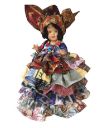A fine brown in a white frame
I went to the market. I was standing at a stall that sold secondhand clothes. When I took a piece of clothing in my hand, I could hear two dark girls standing behind me saying: "Tsk, look at her; looky-loo, but no buy." I then turned around and said "Go on, take it, buy it, but know that the thing has a hole in it!" One girl said to the other: "Didn't I tell you that those white folks understand Surinamese? You have to watch what you're saying!
My grandmother does not see herself as white, but her skin says otherwise. People don't see her fine brown frame. It is her language, Sranan, that gives her skin her true colors. Her skin color is a central theme in my grandmother's life in the Netherlands, the Haagse Markt being another. This market is the place where she used to buy all of her groceries and all of the practical things that she sends to Suriname, box by box. She, like many Surinamese living in the Netherlands, is by herself a whole charity organization. As the godmother of the Haagse Markt, she has many experiences like the one related in the sound bite.
The market was also the place where she bought all of the fabrics and haberdashery that she needed to sow . My grandmother is a gifted seamstress. She knows how to make things and thus, in a way, knows how to produce her own memories. When my grandmother moved, she took with her piles of fabric and a box full of undressed dolls; all of them with dark skin, except for one.
Since my grandmother has become less mobile, she spends a lot of time behind her machine making traditional Surinamese skirts and headscarves for the dolls. But then it happened: the box of dolls was empty, except for that one white doll. It was the only doll that resembled my grandmother's skin color, but also the only doll that she could not identify with.
She decided to dress the doll anyway, but only after it became clear that I could not help her find a new batch of brown dolls. She dressed her in a style known as ala kondre, meaning "all countries", religiously representing all spiritual pantheons of Suriname. My grandmother sent me pictures of the result via WhatsApp adding this:
Yeah, too bad, it is a white doll. But then I thought: well, white people in Suriname also wear kotos. So I figured that since this was the only one left in the box, I should just go ahead and dress it. A lot of work, but it gives me something to do.

